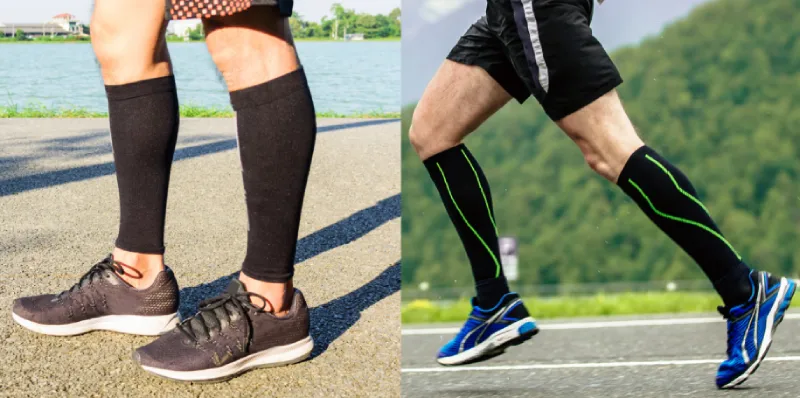
Compression gear is everywhere in sports. Runners, triathletes, and gym-goers swear by compression socks or calf sleeves for performance and recovery. But which one is right for you?
Both options apply pressure to the lower leg, but their coverage—and therefore their benefits—are different. Compression socks cover the foot, ankle, and calf up to the knee, while compression sleeves compress only the calf. That design detail makes all the difference.
This guide explains how each works, when to use them, and how to decide based on your athletic goals.
Quick Answer: Socks or Sleeves?
- Compression Socks: Best for full lower-leg support. They improve circulation, reduce swelling, aid recovery, and provide ankle and foot stability.
- Compression Sleeves: Best for focused calf muscle support. They’re cooler, easier to slip on, and pair well with your favorite socks.
Rule of thumb: Sleeves excel during training or competition, while socks are superior for recovery and circulation support.
How Compression Works in Sports Performance
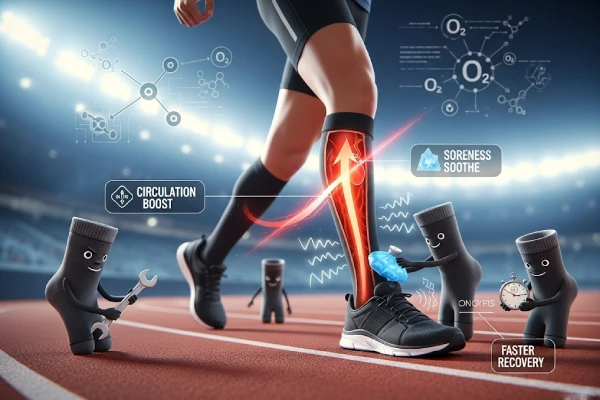
Graduated Compression and Blood Flow
The science behind compression lies in graduated pressure—tightest at the ankle and gradually looser toward the knee. This helps push blood upward, improving oxygen delivery and clearing waste products from muscles.
For endurance athletes, better circulation means fresher-feeling legs and less swelling after long sessions.
Muscle Stabilization and Fatigue
Compression also reduces muscle oscillation—tiny vibrations that occur during running and jumping. Less vibration means less fatigue and lower risk of calf strains or shin splints.
- Socks stabilize the calf, ankle, and foot.
- Sleeves target the calf specifically, supporting the tibia and Achilles.
Running and Training: Which to Choose?
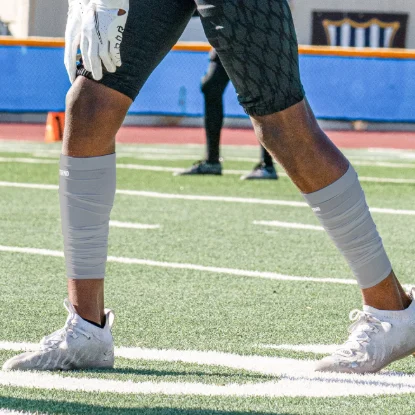

Compression Sleeves for Running
- Lightweight and breathable, perfect in hot conditions.
- Allow you to wear cushioned or blister-prevention socks.
- Popular with triathletes since they can be worn through swim, bike, and run transitions without pulling socks onto wet feet.
- Useful for runners prone to shin splints or calf strains.
Compression Socks for Training
- Add ankle stability and mild arch support.
- Help reduce foot and ankle swelling during long runs.
- Ideal for ultramarathons or back-to-back training where circulation support matters.
Recovery After Workouts or Races
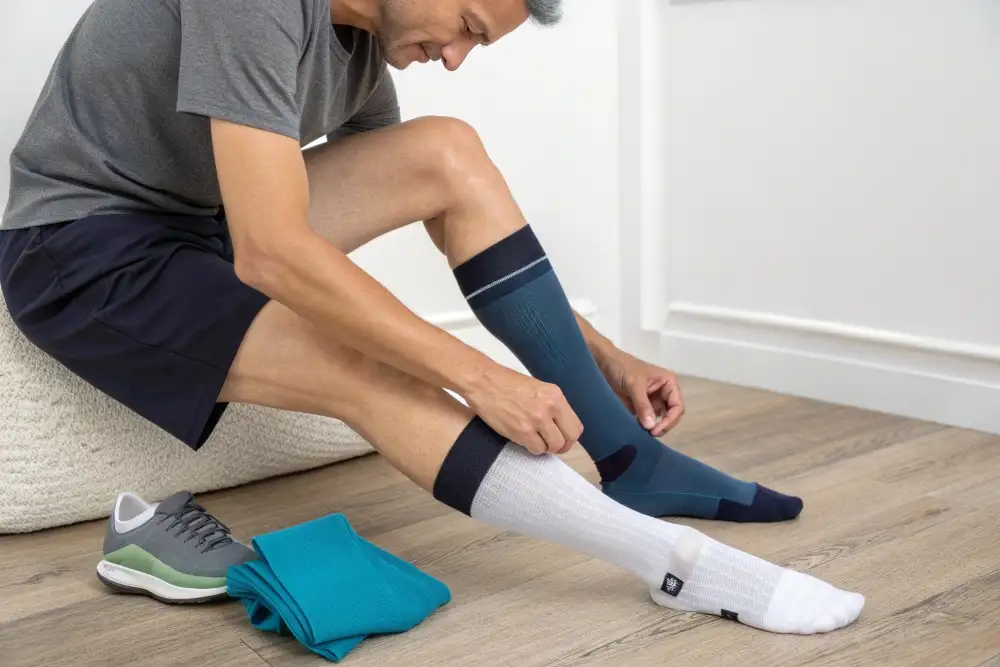
Why Compression Socks Aid Recovery
Research consistently shows that compression socks outperform sleeves when it comes to recovery. Because socks cover the foot, ankle, and calf with graduated pressure, they help blood return toward the heart and prevent fluid from pooling in the lower extremities. This results in noticeably less soreness, faster functional recovery, and reduced swelling after strenuous exercise. In fact, studies have found that wearing compression socks for 24–48 hours after a marathon or heavy training session significantly improves performance in subsequent workouts compared to athletes who skipped compression.
Limitations of Compression Sleeves
By contrast, calf sleeves leave the foot and ankle uncovered. While they still support calf muscles, the lack of coverage can allow fluid to collect in the feet, causing discomfort and delaying recovery. For this reason, most sports medicine experts recommend using socks—not sleeves—after competition or long training sessions.
Best Practices for Athletes
Slip on a pair of compression socks as soon as possible after finishing a long run, race, or heavy leg workout. They can be worn for several hours or even overnight if comfortable. Rotating between two or more pairs helps maintain elasticity and ensures you always have a fresh set ready.
Beyond Running: Other Sports Use Cases
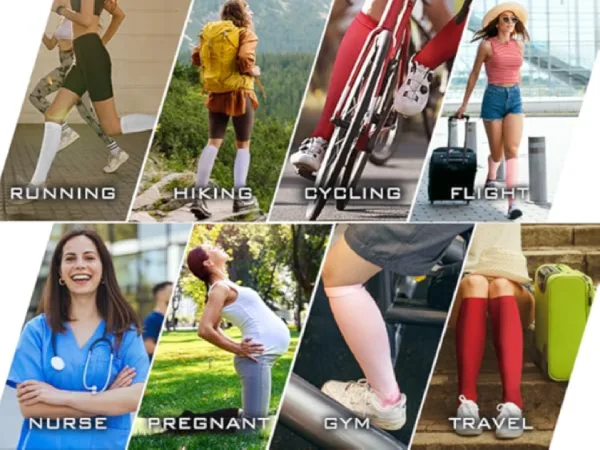
Compression gear isn’t just for runners. Athletes in other sports also benefit from socks and sleeves, but their needs vary. Choose socks if your priority is joint stability and circulation, and go with sleeves if you mainly want muscle-specific calf support and flexibility.
Team and Court Sports (basketball, soccer, tennis)
- Compression socks: Add ankle support and reduce swelling from repetitive jumps, sprints, and quick changes of direction. Particularly valuable for players with a history of ankle sprains.
- Compression sleeves: Lightweight option that targets the calves during explosive sprints or drills without changing shoe fit.
Gym and Weight Training
- Calf sleeves: Useful for plyometrics, box jumps, and high-repetition sets; keep the calves warm and reduce muscle vibration.
- Compression socks: Best for heavy compound lifts (squats, Olympic lifts), where ankle stability and circulation support matter most.
Design, Fit, and Comfort
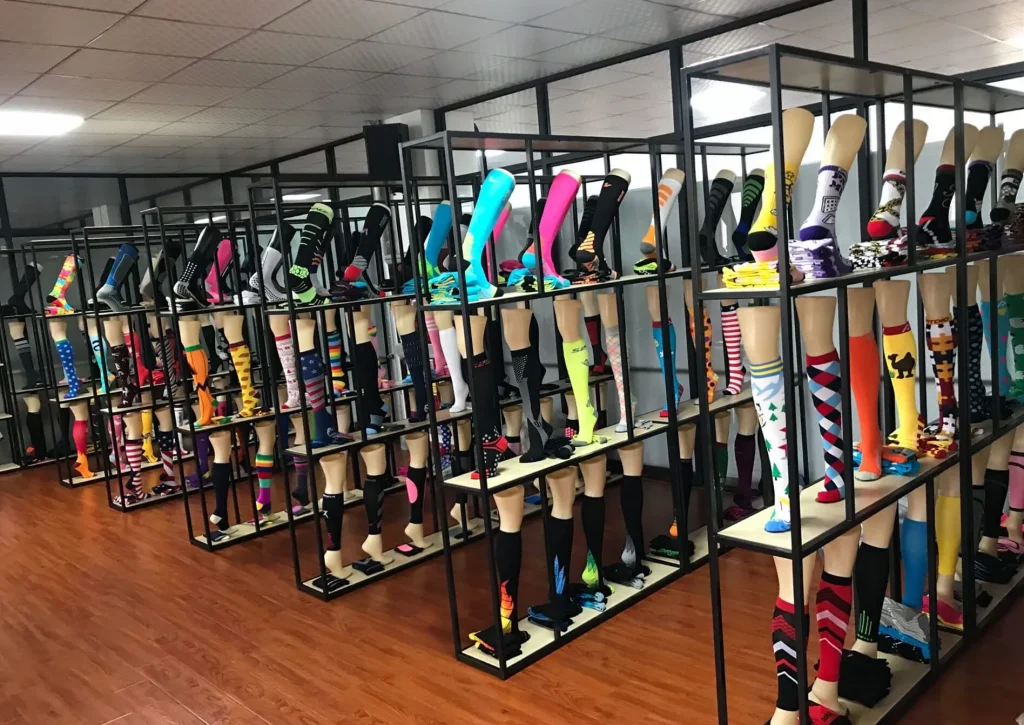
The design and feel of compression gear often determine whether athletes wear it consistently. Here’s how socks and sleeves compare:
Compression Sock and Sleeve Materials for Athletes
Compression socks come in a wide variety of fabrics—synthetic blends for high-intensity training, merino wool for cold-weather endurance, and cotton blends for casual or everyday wear. Calf sleeves, in contrast, are almost always made from synthetic blends such as nylon and spandex, engineered to grip the calf firmly and stay in place during movement.
Finding the Right Fit: Compression Socks vs. Calf Sleeves
Socks must fit across three points: calf circumference, ankle size, and foot length. A poor fit at the foot can reduce effectiveness or cause discomfort. Sleeves are simpler to size because they’re based only on calf circumference and length, which makes them easier to match but less comprehensive in coverage.
Comfort and Practical Use of Compression Gear
Compression socks provide a snug, supportive feel along the full lower leg but can feel warm in summer and take longer to put on. Sleeves are lighter, cooler, and slip on quickly, making them popular for hot-weather training or triathlon transitions. One caution: avoid layering socks and sleeves together, as overlapping compression can cut off circulation.
Cost and Practical Considerations for Compression Socks vs. Sleeves
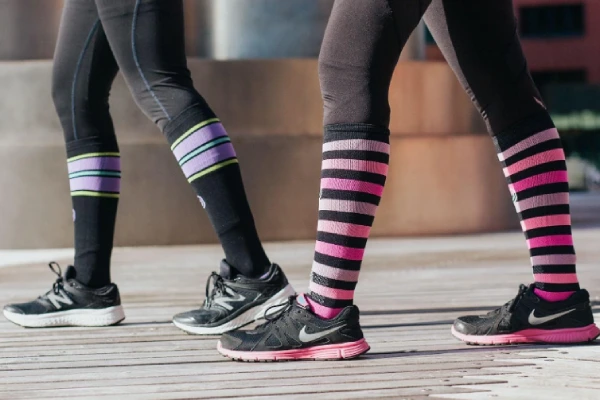
Compression socks typically range from $20 for entry-level models to $100+ for premium or medical-grade versions that guarantee precise graduated compression. Compression sleeves are usually more affordable, priced between $10 and $60, largely because they use less material and provide narrower coverage.
When it comes to maintenance, socks need to be washed after every use due to foot sweat and odor. Sleeves can often be worn more than once if they remain dry, though regular washing is still recommended for hygiene and elasticity. Both socks and sleeves generally last four to six months with frequent use before losing their effectiveness, so rotating multiple pairs is the best strategy to extend their lifespan.
Pros and Cons for Sports Performance
| Category | Compression Socks | Compression Sleeves |
|---|---|---|
| Pros |
|
|
| Cons |
|
|
Compression Socks
- Enhance circulation from foot to knee
- Prevent swelling and speed recovery
- Provide ankle and arch support
- Versatile for training, racing, recovery, daily wear
- Warmer in hot conditions
- Harder to put on
- Require frequent washing
Compression Sleeves
- Focused calf support
- Lightweight, breathable, and quick to wear
- Pair with any sock for custom comfort and cushioning
- Ideal for triathlon or hot-weather running
- No foot or ankle compression
- Limited recovery benefits
- Can worsen foot swelling if worn post-race
FAQs
Are compression socks or compression sleeves better?
Compression socks are generally better for circulation, recovery, and preventing swelling because they cover the foot, ankle, and calf. Compression sleeves work well during training for calf muscle support, but lack the full-leg benefits of socks. The choice depends on whether your priority is performance or recovery.
What are the downsides of compression sleeves?
Calf sleeves don’t compress the foot or ankle, which can lead to swelling after long workouts. They also provide limited recovery benefits compared to compression socks. For athletes who need full lower-leg support, sleeves may not be enough.
When should you not wear compression socks?
Avoid compression socks if you have severe peripheral arterial disease, open skin infections, or uncontrolled diabetes complications. In these cases, compression could restrict blood flow or irritate the skin. Always check with a healthcare professional before using high-pressure socks.
Can compression socks help with dizziness?
Yes—compression socks can improve blood circulation and reduce pooling in the legs, which helps people with conditions like orthostatic hypotension or POTS. By maintaining blood pressure when standing, they may reduce dizziness and lightheadedness.
Is there anything better than compression socks?
For most athletes and travelers, compression socks remain the most effective option for improving circulation and recovery. Alternatives like calf sleeves, ankle supports, or general sports sleeves may help in specific cases, but they don’t replace the proven full-leg benefits of graduated compression socks.
Conclusion: Match the Gear to Your Goal
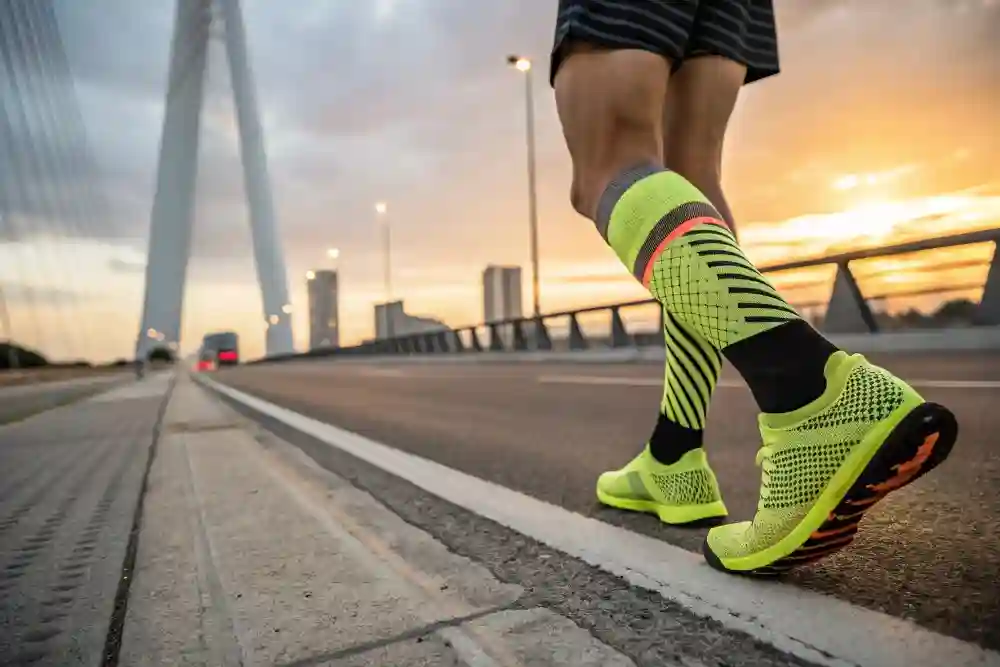
Choosing between compression socks and sleeves depends on your purpose:
- During training or competition → Sleeves are breathable, flexible, and great for pairing with your own socks.
- For recovery and circulation → Socks are proven to reduce swelling, improve blood flow, and accelerate recovery.
- For multi-sport athletes → Owning both gives you the flexibility to use sleeves in races and socks for recovery afterward.
Compression isn’t a magic bullet—but when used correctly, it can help you train harder, recover faster, and feel stronger on the move.
👉 If you’re a retailer, sports brand, or distributor looking to bring high-performance compression gear to your customers, Max Hosiery provides OEM and private-label solutions designed for athletes. Let’s talk about how we can help you expand your product line with proven, in-demand compression wear.
